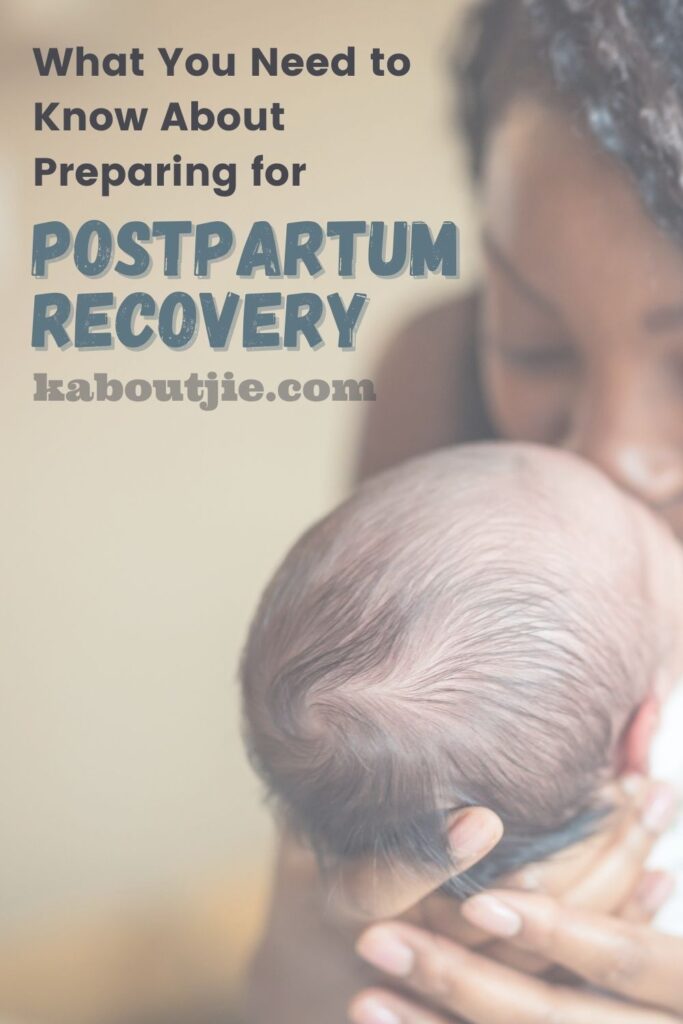After 9 months of pregnancy and long childbirth hours, you finally become a mother able to hold her precious child in your hands. Congrats!
But…
As many (if not all) mothers will tell you, it’s not all smooth sailing from here. A lot goes on during postpartum period, including post-birth recovery. You won’t just have a baby to care for, but also yourself. Despite the ease or difficulty of your delivery and birth experience, you’ll end up feeling sore and uncomfortable, hence the need for some serious post-birth recovery.
Postpartum recovery can be messy, explaining the need for proper preparation. The right supplies and preparation can ease postpartum pains and make transitioning into motherhood seamless.
The transition period between pregnancy and postpartum is clouded with various questions and new symptoms, especially for new moms. And, no matter what kind of birth you had, it can be a challenging and long road to recovery.
Disclaimer: The content provided in this article are general pieces of information, they are not meant to offer medical advice. Please consult your medical doctor or healthcare professional for specific advice related to your personal circumstances.

TIP: Prepare for postpartum recovery just as you do for your baby’s arrival
Set appropriate expectations for yourself (don’t expect too much!) and prepare your partner, family, friends etc. for postpartum recovery. Make sure you set up respectful boundaries.
The postpartum period begins right after birth up to 6-8 weeks later when your body successfully returns to its pre-pregnancy state. Here is everything you need to know about recovery from childbirth or the time prior to delivery to postpartum period, including your postpartum body:
What’s normal bleeding post-birth?
Postpartum bleeding, also known as lochia, can go for about 6 weeks after birth. The heavy period eliminates tissues, leftover blood and mucus from your uterus.
Expect heavy flow 10 days after birth, then it reduces over time. The blood changes in color from red to pink to brown and finally yellowish-white as it wades off.
Consult your doctor if you experience large clots or your flow causes you to use one pad each hour. Your doctor determines whether your flow is normal or postpartum hemorrhage. Avoid using tampons at this time and only use pads.
Learn how to quicken postpartum recovery
You can speed up postpartum healing to hasten your recovery and feel better. Consider the following tips to get you started:
- Care for your C-section scar – use water and soap to clean your C-section incision; do it gently. Nab the area with a clean towel to dry it before applying antibiotic ointment to prevent infections. Your doctor will advise whether to leave the wound open or cover it. Avoid intense exercises and lifting of heavy things, except your baby.
- Ice your perineum for faster healing – 24 hours after birth, apply ice on your perineum every two hours to help it heal faster. Spray it with warm water pre- and post-peeing to prevent urine irritation on the wounds. Indulge in warm sitz bath thrice a day for about 20 minutes to ease pain. Sleep on your side and avoid prolonged sitting or standing periods.
- Ease pains and aches – massages, spas, heating pads, hot showers, and painkillers such as acetaminophen can help you ease pain.
- Do kegel exercises – strengthen your vaginal muscles with kegel exercises to get your vagina back in shape. Do 20 sets of postpartum Kegel exercises daily to resolve postpartum urinary incontinence and make sex more enjoyable for both you and your spouse.
- Make your postpartum bowel movement regular – although your first bowel movement after birth may take time, make it regular afterwards. Consume foods rich in fiber such as fruits, whole grains, and veggies to improve your bowel movements. Gentle stool softeners and walks can also help you stay regular without straining and hurting your C-section scars or perineal tears.
- Gently massage your breasts – use ice packs or a warm compress to gently massage your breasts if they ache. Air your breasts after each nursing session and apply lanolin cream to prevent cracks or treat cracked, sore nipples. When not breastfeeding, wear a comfortable nursing bra for easy access to your breasts whenever you want to feed your baby.
- See your doctor – keep all your appointments with your doctor to ensure that your healing is happening as expected. You can also get emotional help as you adjust to becoming a new mom. Get your stiches removed on time to ensure your scars heal as expected. Ask any question during your appointments and raise concerns such as pain, fever or tenderness around your scars or incision.
- Eat properly to prevent constipation, ease fatigue and promote healing – eat five smaller meals daily instead of 3 larger ones. Fruits, vegetables, and whole grains are rich in fiber to aid digestion and prevent hemorrhoids and constipation. Carbs and proteins provide enough energy to keep you strong. Drink about 8 glasses of water (64 ounces) daily to stay hydrated. Avoid caffeinated or alcoholic drinks to get quality sleep and keep your moods in check.
- Exercise or engage in physical activities – take walks if you’ve had a natural birth or avoid them for the first few weeks for C-section delivery. Your doctor can recommend the right exercises and when you can begin to safely workout. Keep moving around your house or neighborhood to stay active. Exercise improve muscle tone and blood circulation for quicker recovery. It also fights constipation and gas, eases depressive symptoms, and improves moods. Get started with the right postpartum exercises.

Create a checklist of supplies for your postpartum recovery
Create a list of the things you’ll need for postpartum recovery. Start buying them while you’re still pregnant, checking off what you’ve already made available. Consider the following supplies:
Bleeding or lochia essentials
The products promote healing, enhance your comfort level, and prevent infections. They include:
- Maternity pads – thick and large for postpartum bleeding (heavy flows). Include light flow pads, maxi pads, and urinary incontinence pads which work great with pad underwear.
- Chux pads – place where you intend to sit or lie down to prevent blood stains. The underpads are waterproof and protective.
- Mesh underwear – practical enough to hold ice packs and large pads, securing them in place.
- Comfortable underwear – opt for large, disposable (or old) maternity underwear in dark colors (they’re likely to get soiled) to hold the large maternity pads.
- Incontinence underwear – as postpartum bleeding clears up, you may experience some incontinence until your pelvic floor muscles are able to regain strength and function again. Incontinence underwear for women can help manage light incontinence leaks from day-to-day activity.
Don’t use tampons and do change your maternity pads often to prevent infections. Talk to your doctor if you develop fever or show any signs of concern.
Essentials for soothing soreness
Stiches from a tear or an episiotomy, bruised perineum, hemorrhoids, and a C-section incision can cause discomfort during postpartum period. Get the following items to ease your discomfort:
- Disposable washcloths or gauze pads – pat yourself dry with the washcloths or pads after using a peri bottle or the bathroom.
- A squirt or peri bottle – fill it with warm water to squeeze gently over your perineum while urinating or after using the bathroom. This increases blood flow for faster healing, makes pee comfortable, and cleans your perineum to prevent infection.
- Pain medication – always talk to your doctor before using OTC if you’re breastfeeding your newborn. They may be able to prescribe some safe pain medications to manage postpartum pain.
- Numbing solutions – your doctor may also be able to prescribe topical anesthetic foams, creams and sprays to ease pain through a numbing or cooling sensation.
- Ice packs – reduces pain and swellings. Opt for disposable pads with built-in ice packs, disposable packs with chemical activators or DIY ice packs. Don’t apply ice directly on the skin; use paper towels to avoid frostbite.
- A sitz bath – sit on a small tub of cold or warm water for at least 20 minutes. It reduces swelling and pain, and promotes circulation for faster healing.
- A donut pillow – sit on a donut or regular pillow to relieve pressure off your hemorrhoids or swollen perineum.
- Witch hazel tuck pads – use with ice packs to manage postpartum hemorrhoids and vaginal pain. Soothes the area to relieve itching and burning sensations.
- Healthy food, drinks and snacks – stock your pantry with healthy foods, drinks and snacks to eat during postpartum recovery. Food rich in fiber promote bowel movement. You need food for energy and faster body healing.
Talk to your doctor in case of complications or excessive pain.
C-section essentials
These promote healing and ease discomfort. They include:
- A belly pillow – cushions your abdomen when sneezing, coughing, laughing, or holding your baby.
- A stool softener – prevents constipation and pain during bowel movement.
- Comfortable, soft and loose-fitting clothing – prevents irritation and protects incision to foster healing.
- Postpartum recovery belt – shrinks your belly to its original size.
Breast care essentials
- Breast pads – control breast milk leakage.
- A supportive bra – comfortable, convenient and supportive of your heavy, full and engorged breasts.
- Breastfeeding pillow – adds comfort when breastfeeding twins, if your breasts are large or you went through a C-section. It also reduces neck and back strain.
- Lanolin cream for nipple cracks.

Postpartum depression
Nutritional deficiencies can cause postpartum depletion. You just created a life, hence your body is severely depleted of many nutrients such as iron, calcium, vitamins, folate, magnesium, potassium, and choline.
Sleep deprivation, hormonal changes, and the struggle to care for your newborn can take a toll on you and your spouse.
As a result, you can easily develop postpartum depletion of nutrients, energy, sleep, and even sanity, in some cases. The term postpartum depletion is a new term being used instead of postpartum depression.
Lack of these nutrients and imbalances in your body can contribute to depressive symptoms. The symptoms of postpartum depression include:
- Isolated feelings
- Hopelessness
- Anxious or worthless feelings
- Sad emotions
- Loneliness
- Sleep deprivation
- Irritable feelings
Get enough rest and lots of sleep to overcome sleep deprivation and fatigue and optimize mental and physical recovery; sleep whenever the baby falls asleep. You can also get others care for the baby to get time for rest.
Socialize with friends and other family members or moms to fight loneliness.
Don’t feel alone or ashamed of what you experience during postpartum because many women are diagnosed with postpartum depression (1 in every 4 moms).
Talk to your doctor if these symptoms persist for over 2 weeks after birth. This ensures that you get help to be able to care for yourself and the newborn.
Ask for help!
If there’s anything you don’t understand, get help from experienced mothers or your doctor. Get help from friends and family with errands, laundry, cleaning, grocery shopping, meal preparation and other kids or your newborn.
Practical help can foster healing. It also gives you enough time to bond with the baby, and care for it and yourself.
Conclusion
The postpartum period is life-changing, exciting, and can be overwhelming for new moms. With the tips discussed in this article, you can care for yourself and newborn while pushing through postpartum recovery.
Preparing for postpartum can save you time and energy. It also improves your mental and physical healing. Make sure you enjoy every step and detail in postpartum recovery because it only comes once and no two pregnancies or births are the same.

About The Author
Anna Williams is a former aged care support worker and health aid, and has spent many years advocating for better mental and physical health care within the aged care community. She now writes content for Zorbies, volunteers locally, and enjoys long bushwalks on her weekends and spending time with her two pups, Tommy and Zaddie.

 Kaboutjie SA Mommy Blogs by Lynne Huysamen
Kaboutjie SA Mommy Blogs by Lynne Huysamen





There’s a lot to consider and it can be super overwhelming… It’s been nearly 7 years since having a baby and I am feeling a little scared. But I do have a great support structure so I am blessed in that way.
I am 39 weeks and waiting for little ones arrival.
How exciting Natasha!
Very informative and insightful read thank you. If I could there would be many things I wish I could change as well as know more about certain things